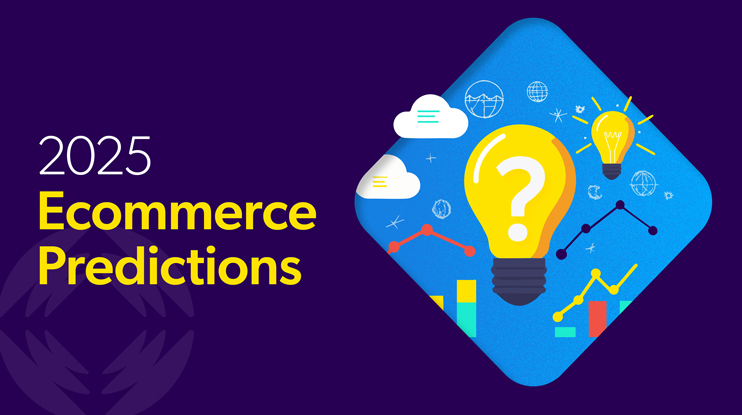What will ecommerce look like in 2025? As the year wraps up, this is a question that naturally comes to mind as we reflect on the shifts we’ve seen and think about what’s next. Predicting trends is a tricky business, but with years of experience at the forefront of digital transformation, I’ve seen firsthand how rapidly the ecommerce landscape can change. Drawing from this expertise and a deep understanding of customer challenges, here are seven key trends that I believe will shape the future of ecommerce in the coming year.
1. The Rise of Conversational Commerce Beyond Chatbots
In 2025, conversational commerce will continue to grow as a critical trend, changing how customers interact with ecommerce platforms. Advances in GenAI are driving this shift, moving beyond traditional chatbot interfaces to deliver more intuitive, conversation-driven shopping experiences. Research by the Boston Consulting Group highlights a key expectation among consumers: the most valued feature in GenAI-powered conversational commerce is its ability to address complex, product-related inquiries. This finding aligns closely with feedback from our own customers, demonstrating the significance of buyer education and knowledge discovery throughout their purchasing journey.
Looking ahead, conversational commerce will likely evolve by integrating AI-powered systems within search frameworks, allowing for more nuanced, fast, and informative interactions. This approach combines the strengths of traditional search with the interactivity of conversational tools, creating a seamless and rich product discovery experience.
As companies like Coveo innovate with GenAI and Retrieval Augmented Generation (RAG), they’ll enhance not only product searches but also customer education, delivering more relevant and fact-based answers that align with shoppers’ needs
2. Transparent AI Will Build Trust
Ecommerce vendors will increasingly prioritize transparency in their use of AI, especially when it comes to product recommendations. By openly explaining why certain items are being suggested — whether it’s based on a customer’s browsing history, past purchases, or common customer behavior — vendors can foster trust and create a more engaging shopping experience. For instance, if a customer is browsing for a hoodie, and AI suggests a pair of pants or a beanie, explaining that these items are frequently purchased together or complement the hoodie’s style can make the recommendation feel more thoughtful and relevant to the shopper’s preferences.
Customers who see the logic behind recommendations are more likely to engage with the suggestions, knowing they are tailored to their preferences. In turn, this can lead to higher conversion rates. By embracing transparency, ecommerce brands can build stronger relationships, fostering a cycle of trust, satisfaction, and long-term loyalty.

When shoppers understand how and why they’re seeing certain products, it demystifies the search and product discovery process, making them feel that their data is being used thoughtfully to deliver personalized, meaningful suggestions.
3. Online Retail Marketplaces and Dropshipping Will Continue to Drive Growth
Onlineretail marketplaces and dropshipping are two of the fastest-growing trends in ecommerce, with both models gaining momentum as they cater to evolving consumer and business needs. The global dropshipping market is expected to reach over $400 billion by 2025, thanks to its low startup costs and the flexibility it offers businesses to operate with minimal inventory, reducing overhead costs and the risks associated with unsold stock. This model is especially attractive to niche markets, allowing businesses to quickly adapt to market trends and consumer demands, and expand their reach globally with minimal overhead.
Meanwhile, online retail marketplaces are experiencing remarkable growth, with consumer spending on these platforms projected to reach $468.33 billion in 2024 in the U.S. alone. This momentum is driven by new entrants like Temu and TikTok Shop, which are shaking up the market by attracting customers with competitive pricing, promotions, and free shipping. The scalability and reach of online marketplaces also play a key role in this surge, offering a broad range of products and fostering competition that appeals to a global customer base. As a result, both buyers and sellers continue to flock to these platforms, fueling their rapid expansion.
Together, retail marketplaces and dropshipping are driving growth innovation across the industry, offering businesses scalable, flexible models and giving consumers more choices and convenience.
4. The AI Hype Will Give Way to the Race to Value
As the initial hype around AI, particularly GenAI, begins to settle, brands are facing mounting pressure to demonstrate a clear return on their AI investments. AI adoption has seen dramatic growth, with McKinsey recently reporting that 72% of organizations globally have incorporated AI into at least one business function. However, by 2025, delivering tangible ROI from AI spending will become the primary focus for both businesses and investors.
The era of speculative AI spending is giving way to a more results-driven, pragmatic approach. Companies are now being held accountable for proving that their AI deployments lead to real-world benefits — whether through increased operational efficiency, new revenue streams, or enhanced customer experiences.
As my colleague Simon Langevin, VP of Product at Coveo, notes, “The AI race is evolving from one driven by hype to one centered on delivering measurable business value, making the ability to demonstrate ROI a necessity for future success.” This shift underscores that the future of AI lies in its capacity to drive concrete business outcomes, with brands that successfully showcase their AI’s ROI standing to gain a competitive edge.
5. The GenAI Build vs. Buy Debate is Slowing Down
When it comes to implementing GenAI capabilities into their ecommerce platforms, companies face the classic “build vs. buy” debate. However, ecommerce brands are quickly discovering that developing their own GenAI solutions is far more complex than originally anticipated. Building from scratch is resource-intensive, requiring access to highly specialized talent, which is costly and often hard to find. Additionally, creating and maintaining AI models demands significant time, infrastructure, and ongoing updates.
For ecommerce brands, speed to market is everything, and building in-house can seriously delay the deployment of AI-powered features that are essential for customer experience and operational efficiency. Brands are also recognizing that the scalability and adaptability of pre-built GenAI platforms far outweigh the benefits of custom development. These platforms come with robust support, regular updates, and seamless integration capabilities, allowing businesses to focus on their core competencies rather than becoming AI developers. Plus, using a vendor allows them to shift the responsibility of maintaining and updating AI models, ensuring they’re always running smoothly without putting extra pressure on internal teams.
Many of the ecommerce brands we’re talking to are now realizing that opting for a SaaS-based GenAI solution is the smartest and most efficient path, enabling them to harness its benefits without the complexities and costs of in-house development.
6. B2B Will Leapfrog Legacy Technology
There’s long been a perception that B2B companies lag behind B2C ecommerce in adopting modern technology, but that oversimplifies things. B2B sales are typically more complex, with intricate product assortments, longer cycles, and multiple decision-makers. The issue hasn’t necessarily been reluctance to adopt new tech, but rather a lack of flexible solutions that can handle these complexities.
However, SaaS platforms are evolving to meet these challenges by improving the flexibility of their data models, ingestion speeds, and merchandising interfaces. This gives B2B companies control that was once reserved for simpler B2C product lines. These advancements, coupled with millennial decision-makers pushing for efficiency, personalization, and self-service, are driving real change in the B2B space.
By modernizing their tech stacks, B2B companies aren’t just catching up — they’re leapfrogging outdated technologies to make digital sales work for more complex products, like industrial pumps and fasteners. Gartner predicts that by 2025, 80% of B2B sales interactions will happen online, but the path forward will continue to balance technology innovation with the realities of B2B’s complex sales processes. Rather than simply catching up, B2B is evolving to meet these needs in ways that prioritize operational efficiency and customer-centric growth.
“The digital transformation in B2B isn’t just about keeping up — it’s about outpacing legacy systems to meet the evolving demands of a new generation of buyers.”
7. Ethical AI Use Will Become a Priority for Ecommerce
As AI becomes more embedded in ecommerce, brands must prioritize ethical considerations, particularly around transparency and data use. The European Union’s AI Act will play a pivotal role in shaping these responsibilities, mandating clear guidelines for AI usage, including transparency obligations, data protection standards as well as environmental sustainability. In addition to regulatory compliance, litigation will inevitably shape the future of AI, as legal challenges around data misuse, algorithmic bias, and AI-driven decisions increase. Brands using AI for product recommendations, customer service, or personalization will be required to inform consumers when AI is in use and how it influences their shopping experience.
To comply, companies need to establish robust policies that ensure responsible AI usage. This includes clearly explaining how AI-driven recommendations are made, addressing concerns about algorithmic bias, and ensuring data security.
Ethical AI use is key to fostering trust; brands that are transparent about their AI systems, avoid biased outcomes, and protect personal data will not only adhere to regulations like the EU AI Act but also build stronger, long-term relationships with their customers.
Other Ecommerce Trends to Watch
While they didn’t make it to the shortlist, there are several other noteworthy developments worth keeping an eye on that have the potential to significantly impact ecommerce.
- Modularity vs. composability: A debate that’s quietly gaining traction as businesses rethink their tech stacks. Are the gaps in fully composable systems pulling people back towards architectures like Shopify’s where there is composable adherence but monolith completeness and convenience?
- GenAI advertising: Enabling brands to deliver highly targeted, personalized and relevant content to individual users based on their preferences and behaviors.
- Visual search: Offering customers a more intuitive way to discover products.
- Sustainable commerce: Still on the rise, driven by consumer demand for eco-friendly shopping options, including the growth of recommerce.
- Multi-agent GenAI apps: These apps are set to proliferate, with vendors who support orchestration emerging to define a new kind of business workflow in ecommerce.


